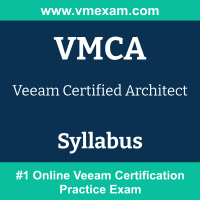 The Veeam VMCA exam preparation guide is designed to provide candidates with necessary information about the VMCA exam. It includes exam summary, sample questions, practice test, objectives and ways to interpret the exam objectives to enable candidates to assess the types of questions-answers that may be asked during the Veeam Certified Architect (VMCA) exam.
The Veeam VMCA exam preparation guide is designed to provide candidates with necessary information about the VMCA exam. It includes exam summary, sample questions, practice test, objectives and ways to interpret the exam objectives to enable candidates to assess the types of questions-answers that may be asked during the Veeam Certified Architect (VMCA) exam.
It is recommended for all the candidates to refer the VMCA objectives and sample questions provided in this preparation guide. The Veeam VMCA 2024 certification is mainly targeted to the candidates who want to build their career in Cloud Data Management domain and demonstrate their expertise. We suggest you to use practice exam listed in this cert guide to get used to with exam environment and identify the knowledge areas where you need more work prior to taking the actual Veeam Certified Architect exam.
Veeam VMCA Exam Summary:
|
Exam Name
|
Veeam Certified Architect (VMCA) |
| Exam Code | VMCA |
| Exam Price | $300 USD |
| Duration | 60 minutes |
| Number of Questions | 40 |
| Passing Score | 70% |
| Recommended Training / Books |
Veeam Backup & Replication v12.1: Architecture and Design Instructor-led training Veeam University |
| Schedule Exam | PEARSON VUE |
| Sample Questions | Veeam VMCA Sample Questions |
| Recommended Practice | Veeam Certified Architect (VMCA) Practice Test |
Veeam VMCA Syllabus:
| Section | Objectives |
|---|---|
| Introduction |
- Review course expectations - Analyze architecture principles - Review Veeam architecture methodology - Define the scope of a design project - List the deliverables of a design project |
| Discovery |
- Describe the data gathering process - List key data to get from stakeholders - Describe possible tools to analyze existing environments - Identify complexity in the environment - Review the course scenario |
| Conceptual design |
- Clarify requirement, constraint, assumption, and risk concepts - Identify received information as requirement, constraint, assumption, or risk - Create high-level infrastructure and data flow diagrams |
| Logical design |
- List required Veeam components based on requirements - Describe logical grouping parameters - Utilize appropriate sizing tools - Create logical designs based on the course scenario |
| Physical design |
- Describe the decision making procedure - List the considerations behind designing backup repositories and VMware backup proxies - Explain the implications of using backup from storage snapshots - Document physical design decisions - Create physical designs based on the course scenario |
| Group presentation |
- Produce a presentation to a customer that summarizes your design - Present your design |
| Implementation and Governance |
- Describe the implementation guide - List possible backup server configurations and security configurations - Define the job design - List the architect obligations for implementation |
| Validation and Iteration |
- List the possible validation tests that can be performed on an implementation - Describe validation tools and procedures - List recovery validations that can be performed on an implementation - Define malware detection methods - Analyze considerations behind starting a new design cycle |
